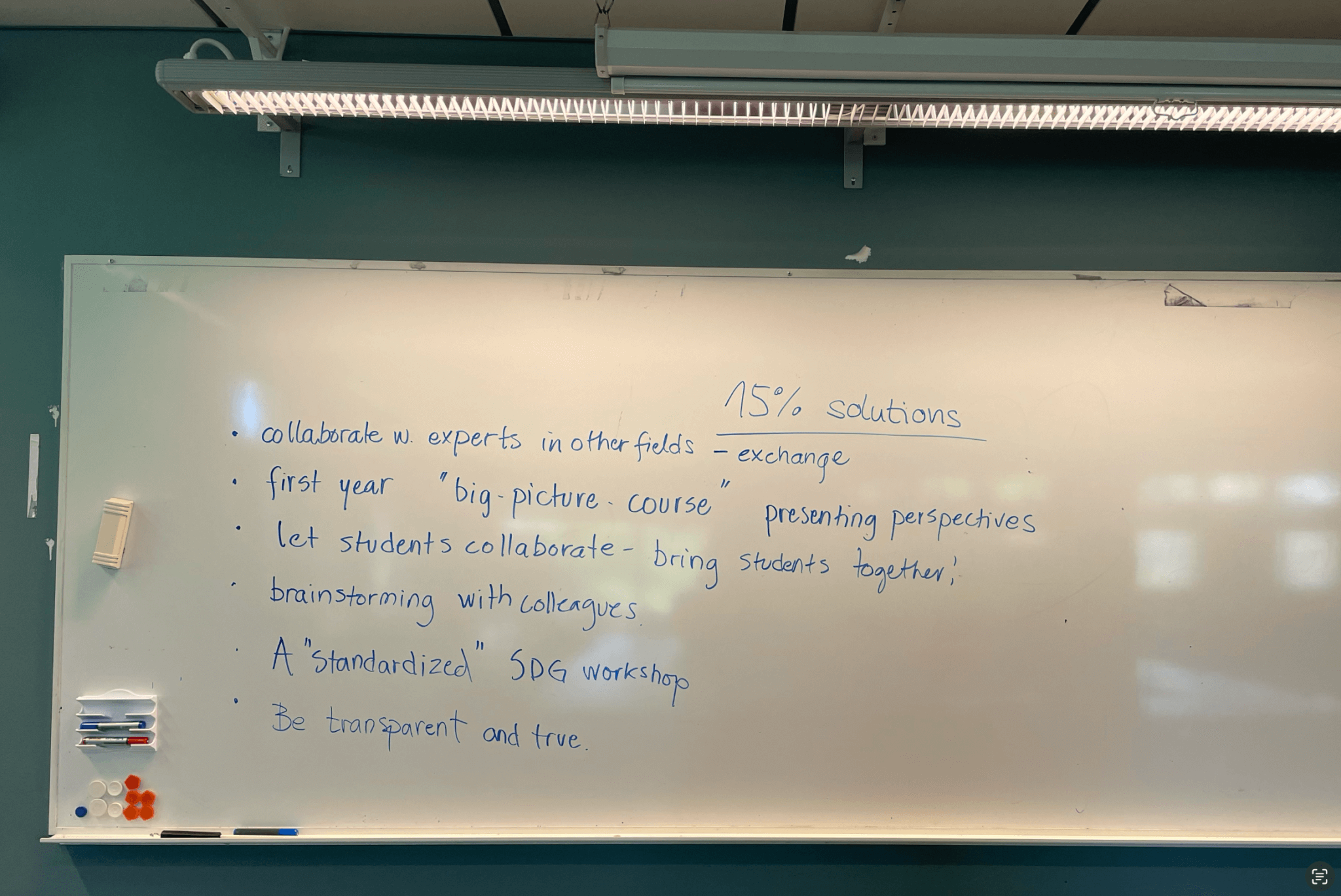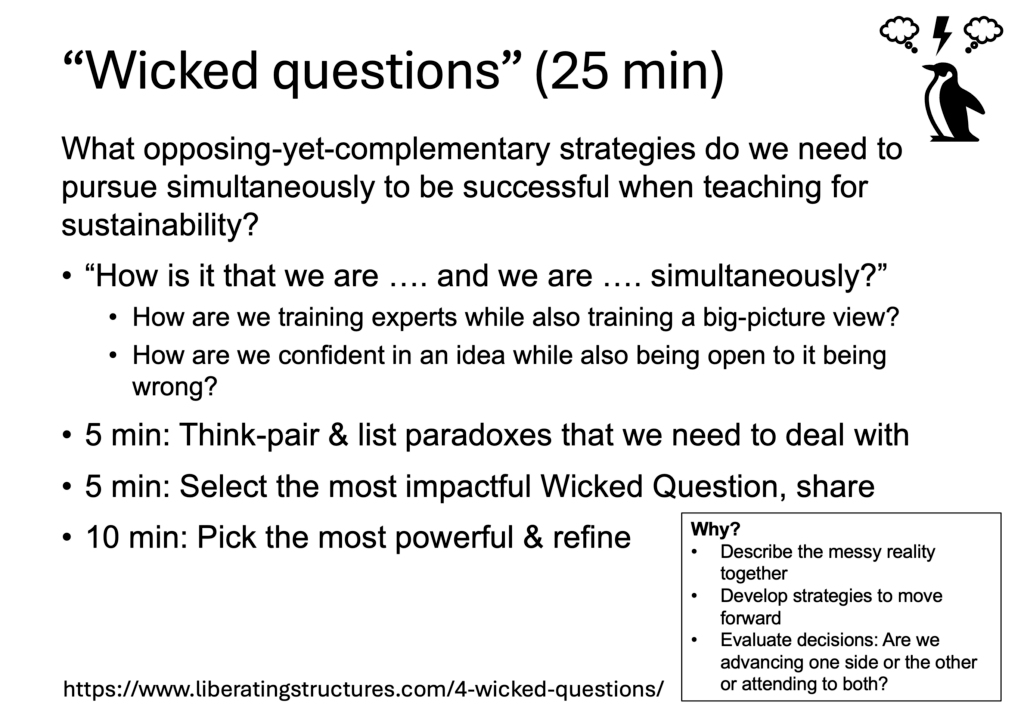
The paradoxes we are confronted with when teaching for sustainability, and attempts at dealing with them, using Liberating Structures
Today, I tried two new “liberating structures” in my “teaching for sustainability” course: First the “Wicked Questions“, where we surfaced some “opposing-yet-complimentary” strategies that we need to pursue simultaneously to succeed, and then we worked towards “15% solutions“, with a focus on small changes that we have the freedom and resources to implement now. And this is how it went.
Below, I am showing the slides that I used to introduce the two structures.
For the Wicked Questions, the goal was to “describe the messy reality together” — in our work, teaching for sustainability, we are often faced with several things that we need to work towards at the same time, even though they are in conflict with each other. So let’s bring it to light and see how we can deal with it!
I gave two examples:
- How are we training experts while also training a big-picture view?
- How are we confident in an idea while also being open to it being wrong?
And maybe I should have taken some that are not related to teaching for sustainability, but just show the structure I was looking for; I think I might have steered the discussion a bit too much with this. But you live and learn…
This was a really difficult exercise, but we got a lot of interesting paradoxes (which I sadly forgot to take a picture of, so they aren’t documented). But one stood out as the one everybody wanted to discuss: How can we show the breath of sustainability (i.e. not just the ecological, but also the economic and social aspects) while being an expert only on one small aspect ourselves?
For that, we used the 15% solutions (except that I did not structure it as clearly as suggested — people only generated a list by themselves, then discussed in groups of 3, and then we brought it together on a whiteboard).
Here are our attempts at 15% solutions:
It is obvious that we cannot bring in all the expertise ourselves (although, as a participant pointed out, we often have to write about impacts our our research in research proposals anyway, so that could be a starting point), so we need to involve others. For example, we can team-teach with colleagues that have complementing expertises (but this obviously gets very expensive very quickly, so that might not be possible to the extent that we would like). But thinking about small steps in that direction, we could ask a colleague from a different field for quick input on a case we are teaching anyway, so if we focus on hydropower from a CO2 perspective, we could ask someone who looks at ecosystems influenced by this, and someone who looks at people that need to move in order to create water reservoirs, and someone who as a perspective from economy. They could come visit one class, or provide us with a slide, send short video message commenting on the case, or just give us feedback that we then tell the students about. We can find such colleagues by cold-calling (one participant told us a success story about that) or through our “Teaching for Sustainability” network at LU.
If we don’t have access to such colleagues, we can still do things like getting in the habit of asking “even though we focus on the aspect x here, what might be the impact on society, economy, ecology?”. We might not have all the answers ourselves, but getting into the habit of widening our perspective (in German “looking over the edge of our own plate”) is certainly a good idea! And we can always assign readings/podcasts/videos that explain other perspectives on our topic. We don’t even necessarily have to have all of them ready at our disposal, it could even be a task for students to find something that explains x from perspective y. There is hardly anything that isn’t available on the internet…
If we are more flexible with the content, there are A LOT of teaching materials available on the SDGs that we can use as they are, or adapt to fit our purposes.
And lastly, it is important to be transparent and clear about what our expertise is, and what it is not. And if we only take one perspective on a topic, we can always point out that it is only ONE perspective, and be explicit that this means that there are a lot of other perspectives (and maybe we have examples) that we are NOT talking about.
So how did it go?
Before the seminar started, I had asked a colleague for feedback on my plan, and whether she thought that this exercise would take too much time away from what participants might want to do most — get feedback and work on their projects. She asked if I might want to let people work on the projects first and then do this exercise after, but I decided to start with this, hoping that ideas from these exercises would find their way into the project work. I don’t know for sure that they did, but listening to all the conversations, both in pairs, small groups, and the big group, I felt like a lot of important points were raised, and also that both structures worked well (even though I need to simplify and adapt a little how I present them). I find these types of reflections so helpful — what are the conflicting goals we have? (And then maybe also what do I value EVEN OVER…) And what baby steps can we do RIGHT NOW to work in the right direction? And even though we spent about 1/3 of today’s seminar time on this, I think that time was really well invested. Now I just need to get feedback on this from participants and colleagues to see if they perceived it the same way… :-)
[Added a couple of minutes after first posting this: My awesome colleague Elisabeth just made the very good suggestion to send out the instructions for the structures before a meeting next time, to give people time to understand the instructions (both the logistics and the questions I want them to think about), so they have the chance to come even more intentional and reflected. Will definitely take this to heart!]
P.S.: Every time I take a photo of the whiteboard to document results, I think of my colleague Jenny who once explained to participants that she always keeps a bit of the room in the picture around the whiteboard, because learning is situated and seeing a bit more context brings back more memories of the situation than just what is written on the whiteboard. I do that a lot for featured images with my desk, what’s on it and on my screen, the weather and season outside of the window, when I am blogging, too. But when I take a picture of a whiteboard, it always reminds me of her…

